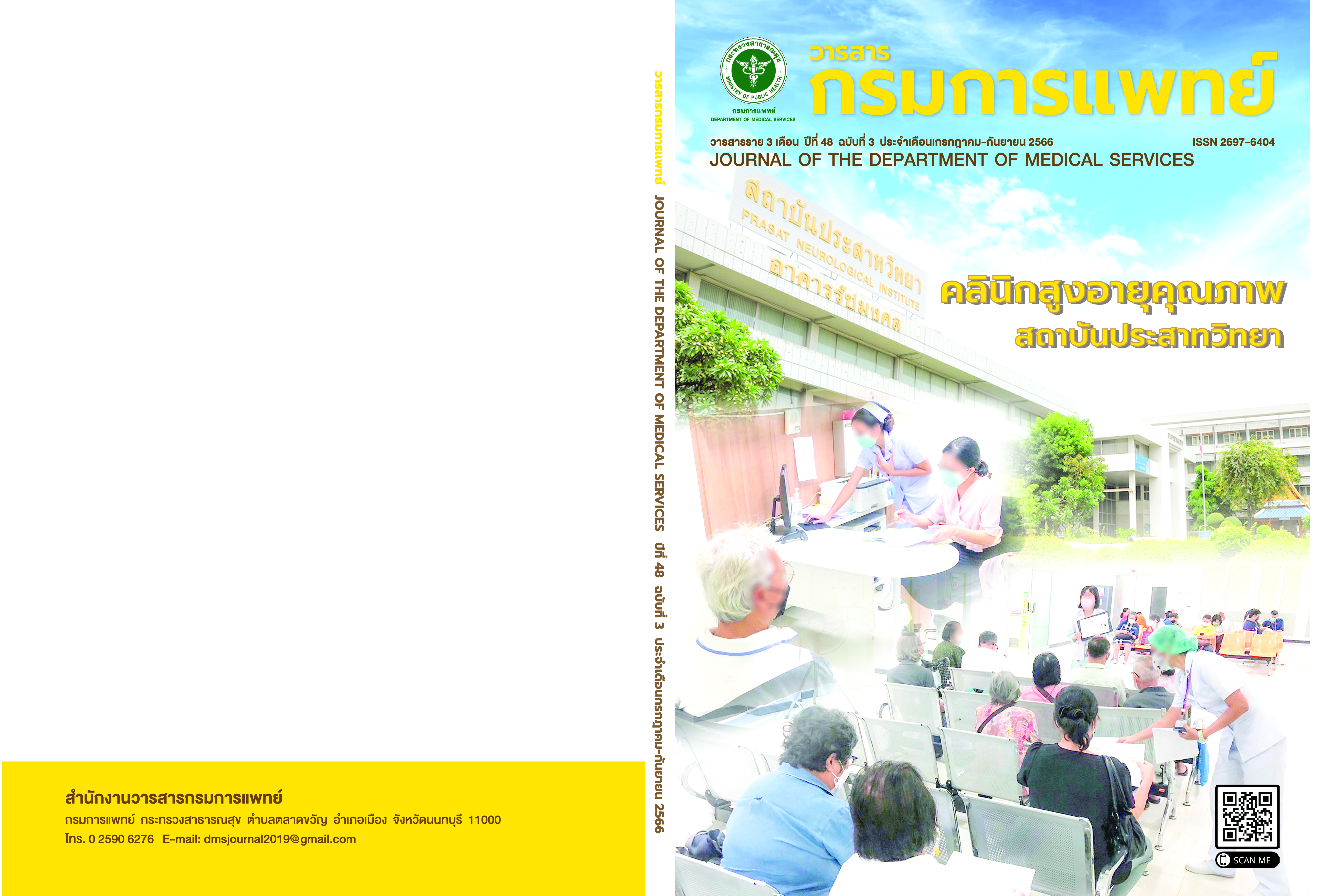เปรียบเทียบผลการเปลี่ยนแปลงน้ำหนักตัวของผู้ป่วยเบาหวานชนิดที่สอง ระหว่างกลุ่มที่มารับยาที่โรงพยาบาลและกลุ่มที่รับยาทางไปรษณีย์ในช่วงที่มีโรคติดเชื้อโควิด-19
คำสำคัญ:
เบาหวาน, โควิด-19, โรคอ้วนบทคัดย่อ
บทนำ: ในช่วงการระบาดของ COVID-19 เป็นสาเหตุทำให้ผู้ป่วยหลีกเลี่ยงการมาโรงพยาบาล ประกอบกับทางโรงพยาบาลราชวิถีเริ่มมีระบบส่งยาทางไปรษณีย์ในช่วงการระบาด วัตถุประสงค์: เพื่อเปรียบเทียบความแตกต่างของการเปลี่ยนแปลงของน้ำหนักตัวควบคุมระดับน้ำตาล ความดันโลหิต ระดับไขมัน ในกลุ่มผู้ป่วยเบาหวานชนิดที่ 2 ที่มารับยาที่โรงพยาบาลและรับยาทางไปรษณีย์ วิธีการ: การศึกษานี้เป็นการศึกษาย้อนหลัง ในผู้ป่วยเบาหวานชนิดที่ 2 จำนวน 304 ราย ผู้ป่วย 202 รายได้รับยาที่โรงพยาบาล และกลุ่มผู้ป่วยที่รับยาทางไปรษณีย์ 102 ราย เปรียบเทียบความแตกต่างของการเปลี่ยนแปลงของน้ำหนักตัว ควบคุมระดับน้ำตาล ความดันโลหิตระดับไขมัน ช่วงก่อนการระบาดและเมื่อติดตามที่ 6 เดือน ผล: ผู้ป่วยในกลุ่มที่ได้รับยาโรงพยาบาลจำนวน 202 คน น้ำหนักเฉลี่ยก่อนการระบาด คือ 14.03±68.95 กก. ลดลงอย่างไม่มีนัยสำคัญเมื่อหกเดือนเป็น 13.78±68.52 กก. (p-value = .097) และกลุ่มยาทางไปรษณีย์ น้ำหนักก่อนหน้าคือ 15.42±71.74 กก. มีการลดลงอย่างไม่มีนัยสำคัญที่หกเดือนเป็น 14.53±69.80 กก. (p-value = .059) และค่าเฉลี่ยการลดน้ำหนักระหว่างสองกลุ่ม ไม่มีความแตกต่างกันอย่างมีนัยสำคัญ (p-value = .152) ส่วนการเปลี่ยนแปลงความดันโลหิต ระดับ FPG, HbA1c, Cr, LDL-C ไม่แตกต่างกันในทั้งสองกลุ่ม ยกเว้นมีค่าการเปลี่ยนแปลง BUN ที่ลดลงมากกว่าในกลุ่มที่รับยาทางไปรษณีย์ สรุป: ผลการศึกษาพบว่าไม่มีความแตกต่างของน้ำหนักตัวระหว่างกลุ่มที่รับยาที่โรงพยาบาลและรับยาทางไปรษณีย์
References
Aekplakorn W, Stolk RP, Neal B, Suriyawongpaisal P, Chongsuvivatwong V, Cheepudomwit S, et al. The prevalence and management of diabetes in Thai adults: the international collaborative study of cardiovascular disease in Asia. Diabetes Care 2003;26(10):2758-63.
Department of Disease Control. The situation of Covid 19. [Internet] 2020 [cited 2020 Jun]. Available from: http://ddc. moph.go.th/viralpneumonia/index.php.
Rajavithi Hospital. Statistics and Medical Records Department. Medical records of diabetes patients in the internal medicine clinic, Bangkok: Rajavithi Hospital; 2020.
Schmittdiel JA, Karter AJ, Dyer WT, Chan J, Duru OK. Safety and effectiveness of mail order pharmacy use in diabetes. Am J Manag Care 2013;19(11):882-7.
Duru OK, Schmittdiel JA, Dyer WT, Parker MM, Uratsu CS, Chan J, et al. Mail-order pharmacy use and adherence to diabetesrelated medications. Am J Manag Care 2010;16(1):33-40.
Zhang L, Zakharyan A, Stockl KM, Harada AS, Curtis BS, Solow BK. Mail-order pharmacy use and medication adherence among Medicare Part D beneficiaries with diabetes. J Med Econ 2011;14(5):562-7.
Schwab P, Racsa P, Rascati K, Mourer M, Meah Y, Worley K. A Retrospective database study comparing diabetes-related medication adherence and health outcomes for mail-order versus community pharmacy. J Manag Care Spec Pharm 2019;25(3):332-40.
Schmittdiel JA, Marshall CJ, Wiley D, Chau CV, Trinacty CM, Wharam JF, et al. Opportunities to encourage mail order pharmacy delivery service use for diabetes prescriptions: a qualitative study. BMC Health Serv Res 2019;19(422):1-8.
Badedi M, Solan Y, Darraj H, Sabai A, Mahfouz M, Alamodi S, et al. Factors associated with long-term control of type 2 diabetes mellitus. J Diabetes Res 2016;2016:2109542.
Huber CA, Reich O. Medication adherence in patients with diabetes mellitus: does physician drug dispensing enhance quality of care? Evidence from a large health claims database in Switzerland. Patient Prefer Adherence 2016;10:1803-9.
Schmittdiel JA, Karter AJ, Dyer W, Parker M, Uratsu C, Chan J, et al. The comparative effectiveness of mail order pharmacy use vs. local pharmacy use on LDL-C control in new statin users. J Gen Intern Med 2011;26(12):1396-402.
Zhang L, Zakharyan A, Stockl KM, Harada AS, Curtis BS, Solow BK. Mail-order pharmacy use and medication adherence among Medicare Part D beneficiaries with diabetes. J Med Econ 2011;14(5):562-7.
Downloads
เผยแพร่แล้ว
How to Cite
ฉบับ
บท
License
Copyright (c) 2023 กรมการแพทย์ กระทรวงสาธารณสุข

This work is licensed under a Creative Commons Attribution-NonCommercial-NoDerivatives 4.0 International License.
บทความที่ได้รับการตีพิมพ์เป็นลิขสิทธิ์ของกรมการแพทย์ กระทรวงสาธารณสุข
ข้อความและข้อคิดเห็นต่างๆ เป็นของผู้เขียนบทความ ไม่ใช่ความเห็นของกองบรรณาธิการหรือของวารสารกรมการแพทย์


